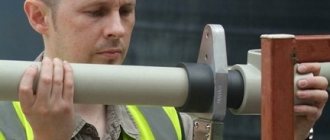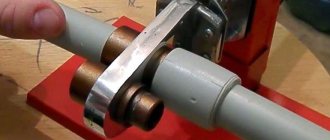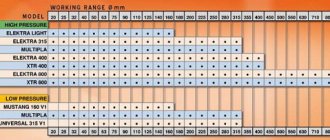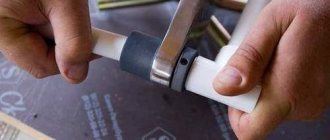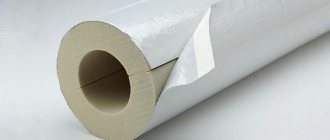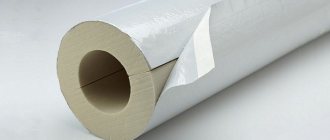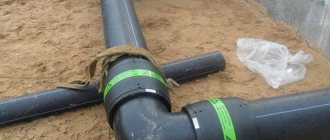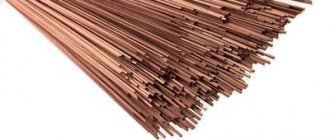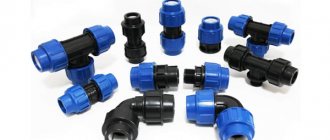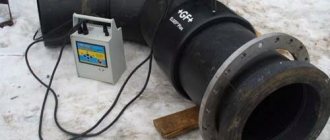Without reliable fixation of pipes during joining, it is impossible to obtain a reliable connection even if the welding work is carried out by a high-class worker. Manual installation and fixation in the desired position takes more time than applying a suture. Therefore, when installing pipelines, a welding centralizer is used, which simplifies and reduces the time required to complete the work.
Some features of pipeline installation
When installing pipelines, it is best to weld the largest number of joints in a rotating position.
If the pipe wall thickness is 12 mm, welding is performed in three layers. The first layer creates penetration at the root of the seam and ensures good fusion of the edges. To perform local penetration, it is necessary that the deposited metal forms a narrow thread-like seam inside the pipe, 1-1.5 mm high, evenly distributed around the circumference.
To ensure penetration without sag or burr, the electrode is given a reciprocating motion, with a slight delay of the electrode above the molten pool of metal, slight transverse vibrations between the edges and the formation of a small hole at the top of the bevel angle of the edges. The hole is made by melting the base metal with an electric arc. The diameter of the hole is equal to the gap between the joints, or exceeds it by no more than 2 mm.
Additional
Regulatory basis for butt welding
As can be seen from paragraph 3, until recently in Russia there was significant confusion with butt welding technology, since several existing regulatory documents gave their own interpretation of it, and therefore most welders preferred to trust the harmonious German DVS technology. And the requirements for butt welding equipment in Russia were not determined by any standard at all.
Since the beginning of 2013, two regulatory documents have come into force in the Russian Federation:
The adoption of GOST for equipment was certainly useful. Unfortunately, this does not mean that the lowest-grade imported equipment was immediately eliminated. But, in any case, the few Russian equipment manufacturers are now forced to work on quality, and the consumer has received a hint on assessing the quality of the purchased equipment.
GOST has brought relative order to butt welding technology. In any case, it led to the uniformity of the technology of butt welding of PE pipes on the territory of the Russian Federation. But the problems remained.
IMPORTANT! GOST R 55276, along with the traditional low-pressure welding mode (similar to DVS 2207-1 and old Russian standards), legalized the high-pressure welding mode of polyethylene pipes, which was previously used only in the USA. This mode places increased demands on the equipment, but allows you to significantly reduce the welding cycle time
IMPORTANT! GOST R 55276 is hardly suitable for direct use on a construction site, since it is aimed not at the welder, but at the developer of the technological map for welding polyethylene pipes. IMPORTANT! GOST R 55276 did not solve the problem of restrictions that plagued the old Russian standards and to this day all foreign standards suffer
Firstly, the permissible range of air temperatures is from +5 to +45°C, while a huge part of the territory of the Russian Federation is forced to start welding when the swamps freeze. Secondly, the maximum pipe wall thickness is 70 mm, while the wall thickness of actually produced pipes has long exceeded 90 mm. For conditions beyond the proven limits of air temperature and wall thickness, some manufacturers have calculated the technology for welding polyethylene pipes by extrapolating current standards, but this theoretical technology has not yet been verified by long-term tests. For non-draining grades of polyethylene, there is no pipe welding technology even in theory. As a result, about 80% of all welding is performed in Russia under conditions that go beyond the limitations of proven technology!
IMPORTANT! GOST R 55276 did not solve the problem of limitations that plagued the old Russian standards and still plagues all foreign standards to this day. Firstly, the permissible range of air temperatures is from +5 to +45°C, while a huge part of the territory of the Russian Federation is forced to start welding when the swamps freeze
Secondly, the maximum pipe wall thickness is 70 mm, while the wall thickness of actually produced pipes has long exceeded 90 mm. For conditions beyond the proven limits of air temperature and wall thickness, some manufacturers have calculated the technology for welding polyethylene pipes by extrapolating current standards, but this theoretical technology has not yet been verified by long-term tests. For non-draining grades of polyethylene, there is no pipe welding technology even in theory. As a result, about 80% of all welding is performed in Russia under conditions that go beyond the limitations of proven technology!
Types of centralizers
There are two ways to divide pipe centralizers into subtypes. They are divided based on the area of fixation and the method of fastening.
According to the fixation area, the guide mechanism for polyurethane foam or metal pipes can be internal or external.
- Internal devices are installed inside the connected sections to fix polyurethane foam pipes or any other materials in the correct position. This equipment is used, as a rule, on large diameter pipelines. It has a rather complex design and includes hydraulic pumps, an engine and locking mechanisms.
- The external centralizer grips the welded joint from the outside. It is a fairly massive clamp with a universal design. It is simpler and more convenient to use.
Centralizer internal
If the internal mechanisms can only work due to hydraulic pumps, then the external ones can be divided into several more categories according to the method of fastening polyurethane foam or any other products of large and small diameter at the joints of pipes.
- chain A chain is attached around the joint using special tensioners, which secures the sections for welding;
- link This device consists of a set of links that can be moved and adjusted based on the diameter of the pipe;
- eccentric. Such centralizers consist of two metal arcs, which are connected by a jumper.
In addition to the main, most commonly used guides, there are several less popular devices:
- external casing spring centralizer. It is used, as a rule, during vertical drilling, to connect pipes of a polyurethane foam well. Such equipment looks like a metal pipe cut along the perimeter with a convexity at the cut points. It is this convexity that gives the equipment a spring effect;
- mobile household devices for connecting small diameter polyurethane foam pipes.
Installation of the unit
The installation of external centralizers is somewhat different from internal ones. It is performed more simply and quickly.
The process of welding metal pipes using an internal centralizer
Installation procedure for the internal device:
- We clean the joints to be connected.
- We fix the unit in one of the elements.
- We fix the spring centralizer near the edge of one of the segments.
- We install the second element close to the first.
- Let's start the engine. Hydraulic pumps compress the sections, leveling them due to the internal diameter.
- Checking the correct connection.
- We cook the joint.
Installation procedure for outdoor device:
- We prepare the joints.
- We install the unit.
- Align the segments by level.
- We tighten the centralizer bolts.
- Checking the correct connection.
- We clamp the tensioners until they stop.
- Let's start welding work.
How to choose a centralizer?
Choosing a centralizer for welding pipes is perhaps one of the main tasks when arranging a water supply, sewerage or heating pipeline.
Centralizer for welding polypropylene pipes
It is this equipment that will allow the pipes to be hermetically connected and maintain the correct slope angle, which is the key to the reliability and durability of any pipeline. The nuances are:
- Decide what cross-section of pipes you will have to deal with. An open unit is quite suitable for working with elements of small diameter (up to 500 mm). To connect products from 500 mm, it is better to use a closed device. It is more difficult to control, but provides a more reliable fixation.
- To choose between chain, link and eccentric models, decide on the amount of work and the thickness of your wallet. Chain models are the cheapest, most functional, but least reliable. Link devices are average in all respects. The most expensive, but most reliable are eccentric centralizers. However, for household pipelines, throwing out $150-200 on auxiliary equipment is at least not rational.
What is a centralizer
Every welder knows that reliable fastening of the welded elements is the key to a good result.
If pipes prepared for welding are not centered and secured securely, they may vibrate and oscillate during operation. This will lead to the seam being bulky, weak and unreliable. At the slightest load it can leak or even burst. Such negligence is not acceptable even when installing small-diameter household pipelines with low pressure and no external load. As for industrial, especially underground, highways, such irresponsibility can be very expensive in the future.
Their task is to securely fix the pipeline joint to ensure a high-quality weld.
Connecting and aligning metal parts using a centralizer
Centralizers consist of a device body (tensioning mechanism), a stand or hook and individual set elements, changing the number of which allows you to connect lines of different, including small, diameters.
This equipment is fixed around the junction of two pipes prepared for welding and pulled tightly using a tensioning mechanism.
In other cases, an external one is used. This is due to the fact that the internal guide device is more expensive and much more difficult to install.
We also note that the centralizer for welding polyurethane foam pipes of large diameter is a rather bulky and heavy device. Therefore, its use requires the use of additional equipment.
Advantages and disadvantages
Like any device, pipe centralizers have their advantages and disadvantages.
The advantages include:
- wide functionality. There is no need to purchase guides separately for each diameter;
- ability to work with both metal and polyurethane foam pipes;
- high-quality and reliable fixation of connected elements;
- the presence of two modifications - internal and external, which allows you to fix sections in any conditions and workspaces;
- ensuring high-quality welds, which are the key to pipeline reliability.
Centralizer for butt welding of polyurethane foam pipes
The disadvantages of this equipment are associated, first of all, with its bulkiness.
- quite high price. However, we note that if you are constantly welding pipelines, centralizers will pay for themselves in a short time;
- complexity of the design. Working with this equipment requires certain knowledge and skills;
- bulkiness and heavy weight (when it comes to welding large-diameter steel and polyurethane foam pipes);
- When connecting large diameter sections, the use of special equipment is required.
Although pipe centralizers have a number of disadvantages, there is nothing more reliable for welding pipelines, especially for industrial purposes. This device will more than pay for itself thanks to the installation of reliable pipelines that will last for years.
What defects may occur during welding?
The biggest defect in welding is considered to be lack of penetration. Welders who experience such flaws are not allowed to work on pipelines. Sloppy seams and their sagging, as well as other minor defects occur when welding technology is violated. To prevent them, work must be performed in compliance with the following conditions:
- welding is performed with a short arc at minimum current;
- detachment of the electrode is allowed only when replacing;
- careful selection of current;
- proper pipe preparation;
- carrying out work with calcined electrodes;
- the welding site must be protected from wind and precipitation;
- use of high-quality equipment and electrodes.
When mastering this type of welding, the main thing is to learn how to deposit the root of the weld. For training, you can take two metal plates 10 mm thick and grab them with a gap, not forgetting about preparing the joint. By fixing them at different angles, they practice welding skills in clearance horizontally, vertically, and on the ceiling.
Features of pipe welding in winter
Such work with pipes in winter has its own difficulties. At low temperatures, the removal of gases from the molten metal deteriorates. As a result, residual stresses remain in the connection, which leads to increased brittleness of the connection.
When the temperature drops, it is recommended to use electrodes of the following brands:
- UONI-13/13;
- UONI-13/55;
- SM-11;
- WCC-1.
Their use makes it possible to obtain a seam with a greater degree of plasticity and toughness.
The work has the following features:
- The joint is cleared of dirt, snow and ice.
- The pipes are connected with minimal gaps.
- The equipment is set to a welding current lower than standard by 15–20%. This makes it possible to improve the cookability of the metal.
- If there is extreme cold, the area is preheated to 200 °C.
There are grades of steel that cook well in frosty weather conditions. These include 14ХГС, 14ГС, 19Г.
Other types
Along with the most popular and widely used equipment, there are less common and specific devices:
- arched;
- centralizer-clamp for pipes;
- spring ones, which are used for use with casing pipes in wells;
- mechanisms for polypropylene products.
The clamp centralizer is used to work with small pipes. This is the most popular variety, suitable for household purposes. These devices are affordable and have compact sizes. A pipe clamp is easier to use. The clamp can be rectangular (trapezoid-shaped) or round. The bottom element is most often flat.
The arch type centralizer is the simplest. It consists of two terminals. They are tightened manually or with hydraulic pumps. The scope of their use is small pipes up to 900 millimeters in size.
Choosing the right centralizer
In order not to make a mistake with your choice, you need to take into account the recommendations of experts:
- For working with large-sized polyurethane foam pipes, internal centralizers are unrivaled.
- For pipes with a diameter exceeding 0.8 m, it is recommended to make connections using rigid arched or multi-link devices for outdoor installation. For smaller sizes, eccentric options will provide sufficient clamping force.
- If the pressure of the pumped substance exceeds 5 atm, a centralizer with a hydraulic clamp is selected.
- If there are increased requirements for the quality of the welded joint (for example, ellipse), a chain centralizer is selected.
- In terms of versatility, chain-type devices occupy first place.
Purchasing a centralizer is necessary if you often have to lay or repair pipelines. The high cost of additional equipment will pay for itself many times over by reducing repair costs and increasing the service life of water and heat supply communications. Especially if they are laid underground.
Models and prices
All centering devices available on the market for tools and devices are divided into two groups based on price:
- Domestic production. They are distinguished by a fairly reasonable price and ease of repair.
- Foreign production. They are distinguished by great ease of use and ergonomics, but have a significant drawback - high price. Among the manufacturers, it is worth highlighting the EU and the USA - their equipment is consistently high quality, but also consistently expensive. The price of products manufactured in Asian countries is slightly lower (with the exception of Japan - the cost of their products may exceed the price of EU products), but there is no guarantee of quality. It can vary greatly from one and the same manufacturer, even within the same batch.
The price of an external centering device ranges around 3-5 thousand rubles per piece (with a manual drive), if the external centralizer for pipes is equipped with a hydraulic drive and often an electric pump for it, the price increases 6-10 times and is about 100-150 thousand.
The cost of internal centering devices, regardless of the manufacturer, does not fall below 250-300 thousand. The presence of hydraulics in their design increases the cost by 35-40%.
When purchasing equipment such as a centering device, you need to focus not so much on the price, but on the expert opinion about the effectiveness of a particular device. Since the price is often high solely due to the advertising of the brand, and not its consumer qualities
Welding instructions
If you chose polyethylene pipes, you acted wisely, but now they still need to be installed correctly. Let's study
Basic rules
Regardless of which technology you choose - electrofusion or butt welding of polyethylene pipes, you must adhere to the following important principles:
- The connected elements must be compatible (both in composition and physical parameters).
- Butt welding of polyethylene pipes can only be done if the parts have the same diameter and equal wall thickness.
- The edges should be thoroughly cleaned and degreased.
- The ends of the structures that are not involved in the connection process must be closed with plugs in order to avoid exposure to cold air, which negatively affects the process.
- During work, it is necessary to minimize the impact of the external environment, namely:
- in hot weather, do not expose the connection area to sunlight;
- in windy weather, create a barrier to gusts of air;
- In cold weather, it is recommended to heat the work area.
- During welding and cooling of the structure, avoid mechanical impact on the system.
Now let’s look in detail at what the technology of butt welding polyethylene pipes is and using the electrofusion method.
Photo fragment of the electrofusion technique: attached heaters
Electrofusion connection
This type of welding, also called thermistor welding, is used for fastening elements of different wall thicknesses and diameters, as well as for installing non-pressure pipelines - drainage installations, gravity sewers, etc.
To connect using this technology, you will need special electric welded fittings. Now remember the order of work.
- Develop a system design.
- Calculate the required number of pipes and other parts.
- Make a purchase.
- Cut the structure into pieces of the length expected by the plan. Make sure that the cut is made smoothly and avoid molten material flowing into the system.
- Prepare and clean parts, including couplings. It would not be superfluous to degrease the surface of the elements using alcohol, applying it to a piece of rag.
- If the surface of the elements is oxidized, remove excess using a special scraper.
- Secure the elements in the positioner, remembering alignment.
- To prevent dust from entering, wrap the connection area with adhesive tape.
- Close the open ends of the structures with plugs.
- Apply voltage to the coupling terminals.
- Wait for the elements to warm up and stick together.
Thermistor welding of polyethylene pipes should be carried out only if the elements being connected are stationary. The structure should remain in the same position until the seam cools completely.
This is what a butt joint setup looks like
Butt welding
The technology and parameters for butt welding of polyethylene pipes are more interesting, since the elements are connected at the molecular level, forming a more durable seam. This method is used for installing elements with a diameter of 50 mm and a wall thickness of 5 mm.
With this method, the edges of the products are heated using a special heating device, and then melted and in this state are joined, forming one whole and a perfect seam.
The procedure for this type of welding up to point No. 7 is identical to the previous connection option (except that couplings are not required for the work).
Table for determining the heating and cooling time of welded elements
And then it differs and follows this “scenario”:
- Insert the ends of the elements into the apparatus so that the heating plate is between them;
- press the edges against the plate and do not change the pressure until the melting process;
- heat the elements, adhering to the standards (the table below for welding polyethylene pipes will help you with this);
- remove the slab and join the ends, applying uniform pressure to them;
- holding the knot, wait for the polyethylene to cool.
Centralizers according to the method of mounting on the pipe
According to the method of mounting on the pipe, all external centering devices are divided into five types:
- Clamps are very convenient for connecting relatively small diameter pipes. Often used by amateur craftsmen and small businesses. Their main part is that the grip can be made in a shape suitable for a specific pipe (trapezoid, circle or parallelepiped). Its lower part provides additional support during installation. Easy to repair, reliable, low cost. Easy to use.
- Eccentric - in design they actually coincide with arched ones, but have a significant addition - an eccentric. It is a lever that pulls together the two working halves of the device. Using an eccentric speeds up centering, but requires considerable experience. If there is an error with the strength and installation location of the device, it may unexpectedly open while welding the pipes. The cost is slightly higher than the arched version.
- Chain - the main part of this device is a kind of chain, tightened on the pipes by a special mechanism. Due to the low-power gearbox, the fastening process is quite labor-intensive, but such a mechanism is reliable and cheap.
- Arched - simple devices of two fastening elements. They are often driven by a hydraulic drive (using human muscle power). Most often they are used when connecting pipes with a diameter of up to 1 meter.
- Multi-link - structurally they are a transitional option between arched and chain. They can have either a manual drive (screw gate) or a hydraulic drive. Highly effective when working with pipes with a diameter of 1 to 2 meters.
Any of them can be equipped with a hydraulic drive and an electric pump for it.
What does the device consist of and how does it work?
At its core, a centralizer is a device that connects the welded joints of two pipes in a perfectly even position. The design allows it to be used for working with pipes of various sizes. It is easy and quick to install and weighs relatively little.
An external centralizer for pipes of any type consists of a connecting device (plates, clamps or chain) and a tightening part (screw gate, bolted connection, hydraulic drive).
To connect two pipes, follow a simple algorithm:
- Clean their joints using an angle grinder, remove rust and other contaminants with appropriate chemicals (rust neutralizer, acetone, white spirit, etc.)
- Place the centralizer on one of the pipes, but do not tighten its fastenings.
- Bring the second one into contact with the first one.
- Move the centering device to the second one and tighten the fasteners with uniform force.
- A visual check is carried out for the correct position of the pipeline and the reliability of the centering device.
- Sutures are applied using gas or electric welding.
As the seam is being applied, the centering device must be carefully loosened and rotated, freeing up the working area for welding. During this procedure you need to be especially careful, as it is easy to deform an unfinished weld seam
Equipment for laying and turning of welded products
The stands do not provide tilting and rotation of products during operation, which makes it difficult to weld bulky and heavy components, therefore the welding installations include special equipment, namely: tilters, rotators, roller stands, manipulators and positioners.
Rotators are stationary devices in which the elements to be welded are not only secured, but also rotated around a horizontal or inclined axis in order to install them in a position convenient for welding, and sometimes to move them during welding. Rotators provide marching rotation of the product around a permanently located axis or around a number of axes lying in the same plane. The tilters have a manual or mechanical drive. Depending on the type of rotary device, there are roller, lantern, trunnion (center) and chain tilters.
Rotators are devices for rotating the welded product at working speed or at marching and working speed around an axis that does not change its position in space. There are rotators with a vertical, inclined or horizontal axis of rotation. Rotators with a vertical or inclined axis of rotation VV (vertical rotator) are sometimes called rotary by analogy with rotary lathes.
Welding rotator with a vertical axis of rotation: 1 – faceplate; 2 – bed with a rotation mechanism.
Roller stands or, otherwise, roller rotators or roller beds are designed to rotate and install the product in a position convenient for welding and to rotate the product at operating speed. The rotation of the product is carried out by driven, usually rubber-coated rollers coupled to the product. A significant advantage of roller stands is that the rotation speed of the product, regardless of its diameter, is equal to the peripheral rotation speed of the rollers. A conventional roller stand consists of a system of idle and driven roller supports mounted on a common foundation plate. Olive stands are used not only for welding, but also for assembly.
Manipulators are universal, usually stationary devices designed to rotate a product around an axis during the welding process at different angles of inclination of the rotation axis.
Universal welding manipulator: 1 – main frame; 2 – rotary frame; 3 – faceplate; 4 – faceplate rotation mechanism; 5 – mechanism for tilting the faceplate; 6 – support legs.
The manipulator consists of the following main components: a frame, a rotary table, drives for rotating and tilting the faceplate and a control unit. In most manipulators, all movements are mechanized. In some designs, the table can be tilted and raised manually. Some of them may not have a table lifting mechanism.
Positioners, unlike manipulators, are not designed for welding rotation of the product and serve only to install and rotate (turn) the product into a position convenient for welding. Positioners or installation manipulators are used both to secure the product and to install it in a position convenient for welding. All positioners are similar in design. They have two or three mutually perpendicular axes around which the faceplate with the product can be rotated or tilted.
Positioner setup diagrams
The positioner table rotates and tilts using a manual or electric drive; it has only a marching speed of movement. Positioners for products weighing more than 1.5 tons are usually electrically driven.
Zvenny
This type of centralizer is considered to be the simplest in design. The device is a multifaceted structure with several links. Depending on the size of the pipes being connected, the links may have the same or different lengths. The number of links depends on the outer diameter of the part.
This equipment is widely used for pipes from 50 to 1500 millimeters in diameter. The device is fixed to the surface using special clamps.
Advantages and disadvantages of centralizers for pipe welding
If you connect the pipes incorrectly, then after a short period of time you may experience serious damage in the form of cracks and breaks, which will cause great losses (especially if the object to be worked on is underground)
Most often, welding work is done in industry, so it is very important to have such fasteners
Advantages of centralizers:
- Ability to work with thermal insulation materials (PUF) of different diameters;
- Reliably fixes products;
- Connects segments qualitatively and firmly;
- It functions perfectly without any glitches.
These are the main advantages of using such devices, but still there are many more of them, since the centralizer is used differently for each type of segment.
The disadvantage of centralizers is that they are quite expensive, so not everyone can afford such a miracle of technology.
Application
Centralizers have a wide range of applications. This is due to the fact that they are designed for welding pipes of various types and diameters. Because of this, they are used in the assembly of pipelines in the municipal and oil and gas industries. Centralizers are used to fix adjacent pipeline fragments during welding.
The relevance of these tools is determined by the great complexity of combining the connections of fragments of main pipelines by welding, especially of large diameters. This is due to sagging due to the low rigidity of the connected fragments. This must be avoided by ensuring alignment. Otherwise, the quality of the connection will significantly decrease. Moreover, it must be taken into account that coaxiality does not always mean parallelism.
Fixing the fragments ensures stable dimensions of the welding zone. In addition, if a centralizer is used for welding, differences are not formed on the inside of the joint, causing flow turbulence and increasing resistance during pipeline operation. That is, these defects worsen the hydraulic parameters, as a result of which more powerful pumping equipment is required.
Precise positioning ensures the same width of the weld around the circumference in the absence of undercuts, lack of fusion, or sagging, which increases strength. In addition, thanks to this, the use of mechanized welding is permissible.
Types of seams
Regardless of what purpose the pipelines are welded for, they have welds that are formed using alternating electric current using a previously selected technology. Today, there are seams at an angle, butt and overlap. They all have their own individual methods and characteristics.
Butt joints are the most common, as they are characterized by the absence of metal deformation. In addition, they are minimally subjected to internal stress and are characterized by high strength with respect to dynamic and static loads. Butt welds are divided into single, used for pipes with a cross-section of up to 500 mm, and double, intended for pipes with a cross-section exceeding 600 mm.
Corner joints are considered butt joints. They are chosen when you need to fasten parts at an angle. Such seams are produced in two ways: without a bevel and with a beveled edge. Corner joints are not as strong as butt joints, but are still of good quality. Overlap seams are great for joining plastic pipes. They are rarely used when welding metal elements. This is explained by the fact that the connections are not very reliable.
Features of the design and use of internal centralizers
Diagram of an arched centralizer.
This type of centering devices belongs to technically more complex, in comparison with external centralizers, installation auxiliary equipment. These centralizers act on the pipe walls from inside the cylinder being welded.
Fundamentally, the operation of this equipment is as follows. A certain force is transmitted to the presses - the working bodies of the internal centralizer, located in two rows along the entire outer diameter of the device - through a hydraulic system. With a given compression force, the presses expand the pipe ends from the inside.
Thus, the pipes are securely fixed in a certain position, coaxial to each other, until the end of welding. Thanks to the large hydraulic force supplied to the presses, this equipment copes well with the technological task already mentioned above: it corrects the ellipsoidal cross-section of the pipe towards the correct cylindrical configuration.
When installed inside a pipeline, such a centralizer is fixed to the edge of one pipe section, and the other section is slid onto the fixture. At the moment of fixing both sections, a specified technological gap remains between the ends of the pipes, necessary for welding.
The internal centralizer moves in the pipeline cavity using a special mechanical rod. To pull the mechanism, which is usually quite heavy, various special equipment (including tractors) is used.
Movement occurs along the entire length of the pipeline, so this auxiliary equipment is generally intended for long-term pipe-laying processes. In this case, welding is carried out practically without significant interruptions.
Internal centralizers behave well under significant temperature changes. They are successfully used in the temperature range from -40 to +45°C.
Main types of centralizers
All mechanisms that are on sale today can be divided into two categories. These are internal and external centralizers.
Outdoor type equipment is designated “CN”. These systems are designed for installation on the outside of the articulated elements. Regardless of the overall dimensions, they are easy to use, easily mounted on the pipe and allow alignment to be carried out as quickly and efficiently as possible. External devices are a wide liver of centralizers. There are eccentric, link, hydraulic and other configurations.
The internal centralizer for pipes is designated “CV”. It is a hydraulic installation. Equipment of this type pushes the edges of the connected pipes from the inside, shifting the media towards each other. The advantage is the ability to use the tool for products of different diameters.
Preparatory work
Before welding the pipe, it is necessary to prepare the metal in the joint area. The ends must be cut straight, otherwise it will be difficult to apply a reliable seam. The edges are chamfered so that the angle between them is 65 - 70˚. Surfaces at a distance of at least 3 cm from the ends are cleaned with a grinding machine or a metal brush until shiny inside and out. Areas that have changed color after treatment with a sander are removed. Burrs are removed with a file. The sharp edges of the edges are dulled to 2 mm, otherwise they will quickly melt. Then the surfaces are degreased with acetone.
The preparation of the electrodes is no less important. Before starting work, they are calcined in an oven at a temperature of 380 - 400˚C for two hours. For long-term storage, the electrodes are placed in a special case in which the temperature is maintained at 80˚C. A container for this purpose can be made independently from a polyurethane foam pipe. When long-term calcination is not possible, the electrodes are dried with a burner for one and a half minutes with a low flame. This method is prohibited by the rules, but in an emergency there is no choice. Since the coating of the electrodes dries quickly and picks up moisture again, you should not dry more than two pieces at the same time.
